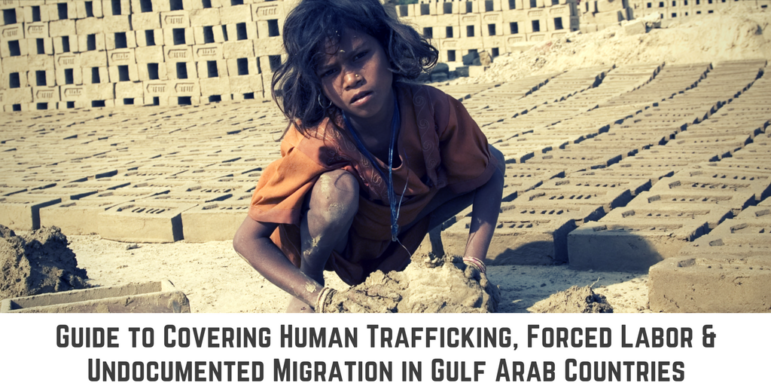
Over 11 million migrant workers work in the six Middle Eastern countries — Saudi Arabia, Kuwait, the United Arab Emirates, Qatar, Bahrain and Oman — that make up the political and economic alliance known as the Gulf Cooperation Council (GCC). Migrants comprise an extraordinary 67 percent of the labor force in these countries. Reforms in labor laws, adopted by just a few Gulf countries, are rarely implemented.
Abuse of these workers is widespread, with contract violations, dangerous working conditions and unscrupulous traffickers, brokers and employers. Media outlets, both local and international, have generally not covered this topic closely. Journalists attempting to investigate human trafficking and forced labor in the region have faced a lack of information, restrictions on press freedom and security threats. Some have faced detention and deportation.
Guides by Country and Topic
For these reasons, GIJN, in collaboration with human rights organizations, is launching this first bilingual guide to teach journalists best practices, tools and steps in reporting on human trafficking and forced labor in the Gulf region. We’ve divided this guide into seven sections:
- GCC Reporting Guides — Migrant-Rights.org has developed this country-by-country guide for covering labor migrant and human trafficking issues:
- Trafficking Case Studies — Profiles of 10 stories of trafficking and forced labor with themes common throughout the region.
- Statistics and Studies — Where to find Data? — Resources for data related to trafficking, forced labor and irregular migration, with an overview of useful studies.
- Essential Reading — Useful sources for understanding trafficking, forced labor and irregular migration issues in the Middle East.
- Guide to Experts — Where to find experts on human trafficking, forced labor and irregular migration.
- Key Terms — Important terms for covering human trafficking and forced labor in the Middle East.
- Trafficking & Forced Labor Glossary — A glossary of terms specific to trafficking, forced labor and irregular migration in the Gulf region. For a comprehensive glossary on migration terms, see the International Labour Organization’s media-friendly glossary here.
Finding Stories
- Stories on trafficking and forced labour are everywhere. Local organisations and embassies are plentiful sources.
- New or recently passed or recently enforced legislation is also a starting point for stories. There’s often not much substantive follow-up on the implementation of legislation affecting migrant workers that includes comprehensive interviews with workers, employers, recruiters or government officials. Measuring the impact of the wage protection system or kafala reforms are examples of much-needed stories.
- Detention centers are also a major source of information, if you are able to talk your way in.
- Striking up conversations with the people you encounter every day is also very likely to lead you to a story.
- Understand what forced labor is and be able to spot patterns in seemingly unrelated news. For instance, a health outbreak in labor accommodation or economic recession will have repercussions on labor mobility, and the far bigger story of human strife often gets buried under national economic fallout.
Fair Coverage
- Make sure migrant perspectives are included in reports, and make sure those perspectives are varied. Migrants from different countries and in different sectors are likely to have different opinions and different stories to tell. For example, if a new policy comes out that affects the migrant population, get their perspective rather than recycling a government press release.
- Remember that victims of trafficking or other traumatic events often struggle to recall events in the proper order, and their stories may change. This doesn’t mean they are lying.
- Make sure to get the consent of anyone who is photographed or interviewed, and make sure they understand your request in a language he or she understands. As you cannot obtain the consent of a deceased worker, do not photograph migrants who have committed suicide or otherwise passed.
- Special care needs to be taken with abused workers.
- Photographs of abused migrants are not the story. If you’re publishing a photograph of a bruised individual with only three lines accompanying the photo, you’re not doing justice to the worker’s experiences.
- Be careful with your language. There’s a tendency in both English and Arabic-language media to use words that dehumanize migrants and advance negative stereotypes. Our glossary offers suggestions on best-use terminology.
Be Cautious
- Protecting you and your sources, especially if they’re migrants or support migrants, is of utmost importance.
- Make sure you have any necessary permits or special visas for your work.
- Make sure to request a response from government departments, if relevant, to help avoid defamation claims.
- Protect workers’ privacy. Make sure to use pseudonyms for migrant workers if they are undocumented or if they might face a backlash from their employer. If you’re reporting on a migrant worker in distress, sometimes it’s best to wait until they’ve been helped or repatriated before publishing a story. Don’t publish documents with workers’ passport numbers or national IDs.
- Use encryption and encourage your sources to do this as well. Signal and WhatsApp are both encrypted.
- If you can’t publish an important story with your name on it, or publish it in a local publication, pitch to international publishers or publishers in countries of origin. It’s important these stories get out.
Data and Statistics
- Keep in mind that most global data related to migration doesn’t adequately represent the MENA region because of the difficulty in gathering surveys and the lack of availability of data in these countries.
- Also remember that data doesn’t always differentiate between labor, forced migration and refugees.
- Don’t take official statistics at face value. Check the definitions used to determine things like the number of trafficking incidents or the methodology used to calculate the number of complaints lodged by workers.
- Keep an eye out for English-language news from countries of origin. There’s often statistics on populations in the region, the most popular migration destinations, the number of complaints workers have made in particular countries, etc. Get in touch with reporters and see if they might connect you with their sources or to more information.
 This guide was developed by Migrant-Rights.org in partnership with the Global Investigative Journalism Network. Migrant-Rights.org is an advocacy organization that aims to advance the rights of migrant workers in the Middle East. Follow them on Twitter at @MigrantRights.
This guide was developed by Migrant-Rights.org in partnership with the Global Investigative Journalism Network. Migrant-Rights.org is an advocacy organization that aims to advance the rights of migrant workers in the Middle East. Follow them on Twitter at @MigrantRights.
